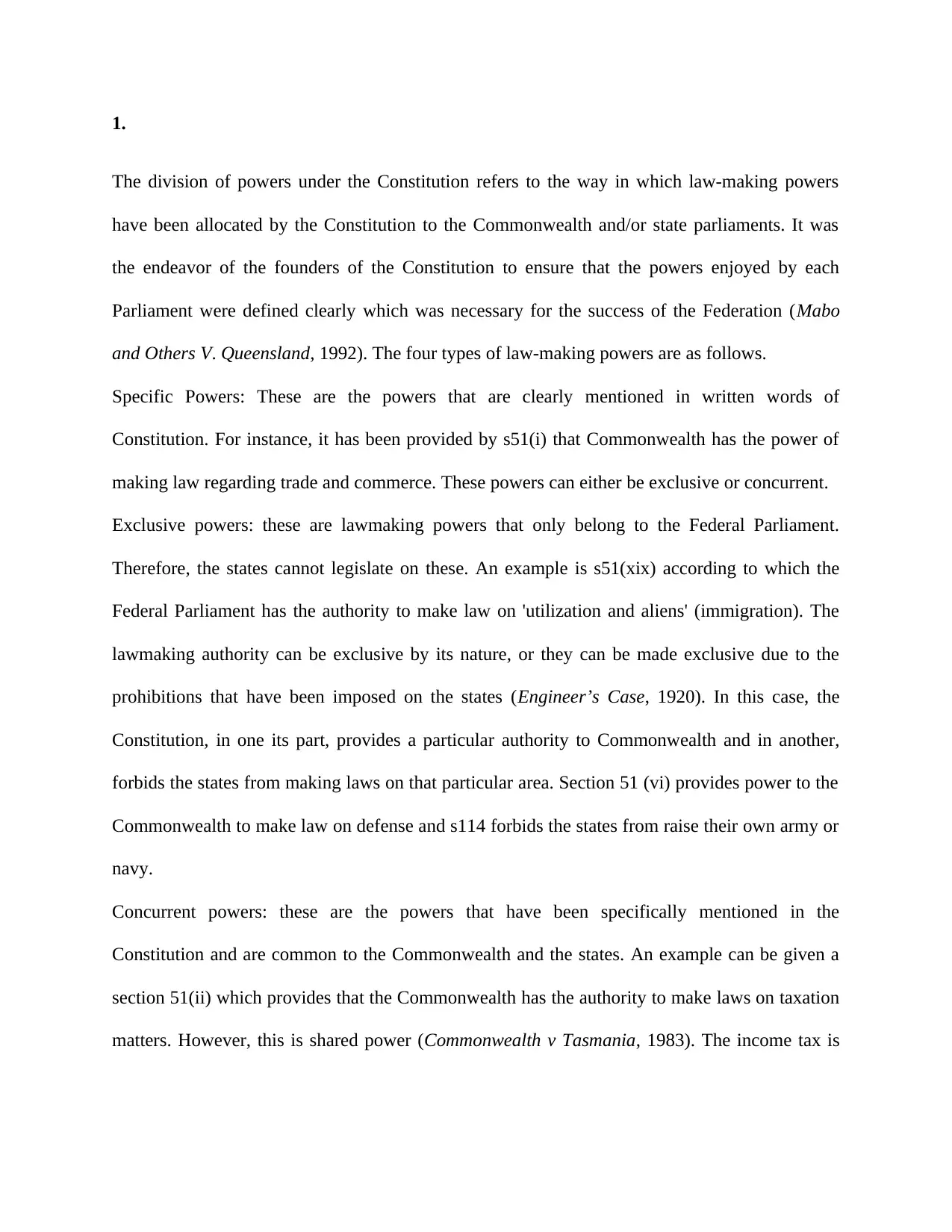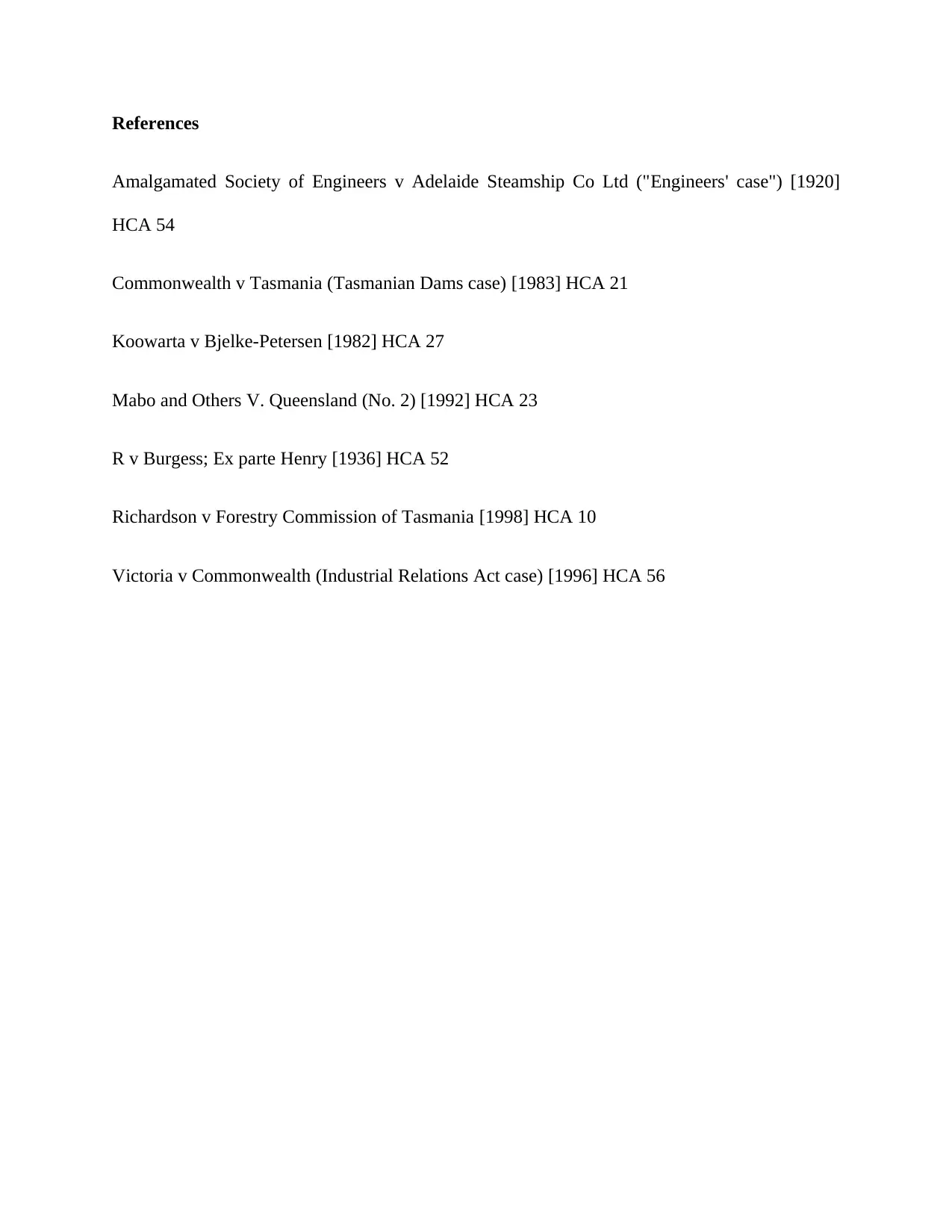Exploring Law-Making Powers: Division Under the Constitution
VerifiedAdded on 2023/06/08
|4
|804
|333
Essay
AI Summary
This essay examines the division of law-making powers under the Australian Constitution, focusing on specific, exclusive, concurrent, and residual powers. It discusses how the High Court rulings and federal funding have strengthened the Commonwealth Parliament's law-making capabilities since Federation. The essay also highlights the impact of social and technological advancements on the distribution of these powers, referencing key cases and constitutional sections to illustrate the evolving dynamics between federal and state governments in Australia. Desklib provides access to similar solved assignments and study tools for students.

1.
The division of powers under the Constitution refers to the way in which law-making powers
have been allocated by the Constitution to the Commonwealth and/or state parliaments. It was
the endeavor of the founders of the Constitution to ensure that the powers enjoyed by each
Parliament were defined clearly which was necessary for the success of the Federation (Mabo
and Others V. Queensland, 1992). The four types of law-making powers are as follows.
Specific Powers: These are the powers that are clearly mentioned in written words of
Constitution. For instance, it has been provided by s51(i) that Commonwealth has the power of
making law regarding trade and commerce. These powers can either be exclusive or concurrent.
Exclusive powers: these are lawmaking powers that only belong to the Federal Parliament.
Therefore, the states cannot legislate on these. An example is s51(xix) according to which the
Federal Parliament has the authority to make law on 'utilization and aliens' (immigration). The
lawmaking authority can be exclusive by its nature, or they can be made exclusive due to the
prohibitions that have been imposed on the states (Engineer’s Case, 1920). In this case, the
Constitution, in one its part, provides a particular authority to Commonwealth and in another,
forbids the states from making laws on that particular area. Section 51 (vi) provides power to the
Commonwealth to make law on defense and s114 forbids the states from raise their own army or
navy.
Concurrent powers: these are the powers that have been specifically mentioned in the
Constitution and are common to the Commonwealth and the states. An example can be given a
section 51(ii) which provides that the Commonwealth has the authority to make laws on taxation
matters. However, this is shared power (Commonwealth v Tasmania, 1983). The income tax is
The division of powers under the Constitution refers to the way in which law-making powers
have been allocated by the Constitution to the Commonwealth and/or state parliaments. It was
the endeavor of the founders of the Constitution to ensure that the powers enjoyed by each
Parliament were defined clearly which was necessary for the success of the Federation (Mabo
and Others V. Queensland, 1992). The four types of law-making powers are as follows.
Specific Powers: These are the powers that are clearly mentioned in written words of
Constitution. For instance, it has been provided by s51(i) that Commonwealth has the power of
making law regarding trade and commerce. These powers can either be exclusive or concurrent.
Exclusive powers: these are lawmaking powers that only belong to the Federal Parliament.
Therefore, the states cannot legislate on these. An example is s51(xix) according to which the
Federal Parliament has the authority to make law on 'utilization and aliens' (immigration). The
lawmaking authority can be exclusive by its nature, or they can be made exclusive due to the
prohibitions that have been imposed on the states (Engineer’s Case, 1920). In this case, the
Constitution, in one its part, provides a particular authority to Commonwealth and in another,
forbids the states from making laws on that particular area. Section 51 (vi) provides power to the
Commonwealth to make law on defense and s114 forbids the states from raise their own army or
navy.
Concurrent powers: these are the powers that have been specifically mentioned in the
Constitution and are common to the Commonwealth and the states. An example can be given a
section 51(ii) which provides that the Commonwealth has the authority to make laws on taxation
matters. However, this is shared power (Commonwealth v Tasmania, 1983). The income tax is
Paraphrase This Document
Need a fresh take? Get an instant paraphrase of this document with our AI Paraphraser

legislated and regulated by the Commonwealth while the land tax is legislated and regulated by
the states (Koowarta v Bjelke-Petersen, 1982).
Residual powers: residual powers are the lawmaking powers that have not been mentioned in the
Constitution. As a result, these powers only belong to the states. The examples of such powers
are crime and education. It may result in inconsistent laws being introduced by different states.
2.
Since Federation, there have been several rulings of the High Court. Due to which the
lawmaking powers of the Commonwealth Parliament have been strengthened. The High Court
has the power to resolve any difference between federal and state governments regarding the
lawmaking powers (Victoria v Commonwealth, 1996). If a law has been killings, the High Court
has to decide if the relevant Parliament has been given the power to make law by the
Constitution.
The dependence of the states on funding by the federal government to pay for activities like
schools and hospitals has also resulted in a shift in the balance in favor of the Commonwealth.
Federal funding grants amount up to nearly half of the total revenue earned by the states.
According to s96 of Constitution, the Commonwealth has the authority to endow 'financial
assistance to any state'. Due to this reason, the federal government was in a position to give 'tied
grants' to the states by directing how the money was going to be spent by the states (Richardson
v Forestry Commission of Tasmania, 1998). The federal government can also influence the way
things are done in areas like health, education, urban development, housing, which are mainly
the responsibilities of the states (R v Burgess, 1936).
the states (Koowarta v Bjelke-Petersen, 1982).
Residual powers: residual powers are the lawmaking powers that have not been mentioned in the
Constitution. As a result, these powers only belong to the states. The examples of such powers
are crime and education. It may result in inconsistent laws being introduced by different states.
2.
Since Federation, there have been several rulings of the High Court. Due to which the
lawmaking powers of the Commonwealth Parliament have been strengthened. The High Court
has the power to resolve any difference between federal and state governments regarding the
lawmaking powers (Victoria v Commonwealth, 1996). If a law has been killings, the High Court
has to decide if the relevant Parliament has been given the power to make law by the
Constitution.
The dependence of the states on funding by the federal government to pay for activities like
schools and hospitals has also resulted in a shift in the balance in favor of the Commonwealth.
Federal funding grants amount up to nearly half of the total revenue earned by the states.
According to s96 of Constitution, the Commonwealth has the authority to endow 'financial
assistance to any state'. Due to this reason, the federal government was in a position to give 'tied
grants' to the states by directing how the money was going to be spent by the states (Richardson
v Forestry Commission of Tasmania, 1998). The federal government can also influence the way
things are done in areas like health, education, urban development, housing, which are mainly
the responsibilities of the states (R v Burgess, 1936).

The lawmaking powers of the Federation have also increased to deal with huge social and
technological advances that have taken place since Federation. As the society in Australia has
changed, so does the issues faced by the Federal Parliament.
technological advances that have taken place since Federation. As the society in Australia has
changed, so does the issues faced by the Federal Parliament.
⊘ This is a preview!⊘
Do you want full access?
Subscribe today to unlock all pages.

Trusted by 1+ million students worldwide

References
Amalgamated Society of Engineers v Adelaide Steamship Co Ltd ("Engineers' case") [1920]
HCA 54
Commonwealth v Tasmania (Tasmanian Dams case) [1983] HCA 21
Koowarta v Bjelke-Petersen [1982] HCA 27
Mabo and Others V. Queensland (No. 2) [1992] HCA 23
R v Burgess; Ex parte Henry [1936] HCA 52
Richardson v Forestry Commission of Tasmania [1998] HCA 10
Victoria v Commonwealth (Industrial Relations Act case) [1996] HCA 56
Amalgamated Society of Engineers v Adelaide Steamship Co Ltd ("Engineers' case") [1920]
HCA 54
Commonwealth v Tasmania (Tasmanian Dams case) [1983] HCA 21
Koowarta v Bjelke-Petersen [1982] HCA 27
Mabo and Others V. Queensland (No. 2) [1992] HCA 23
R v Burgess; Ex parte Henry [1936] HCA 52
Richardson v Forestry Commission of Tasmania [1998] HCA 10
Victoria v Commonwealth (Industrial Relations Act case) [1996] HCA 56
1 out of 4
Related Documents
Your All-in-One AI-Powered Toolkit for Academic Success.
+13062052269
info@desklib.com
Available 24*7 on WhatsApp / Email
![[object Object]](/_next/static/media/star-bottom.7253800d.svg)
Unlock your academic potential
Copyright © 2020–2025 A2Z Services. All Rights Reserved. Developed and managed by ZUCOL.





